Hong Kong Cricket: Proprioceptive Training and Player Agility
VerifiedAdded on 2020/10/23
|6
|1291
|296
Report
AI Summary
This report investigates the impact of proprioceptive training on the agility of Hong Kong national first-team cricket players. The study explores the background of cricket, highlighting the importance of agility for various roles like batting, fielding, and bowling, as well as the role of proprioceptive training in enhancing joint control and preventing injuries. It addresses common cricket-related injuries, particularly ankle sprains, and aims to determine the effectiveness of proprioceptive training on agility. The report defines key terms, including proprioceptive training, agility, and training programs, while also outlining the study's assumptions, limitations, and delimitations. Furthermore, the research utilizes both primary and secondary research methods, including interviews with cricketers and literature review, to assess the impact of proprioceptive training on player performance. The study is significant for identifying the importance of proprioceptive training in preventing injuries and improving performance within the Hong Kong national cricket team, and the references include relevant books and journals that support the research.
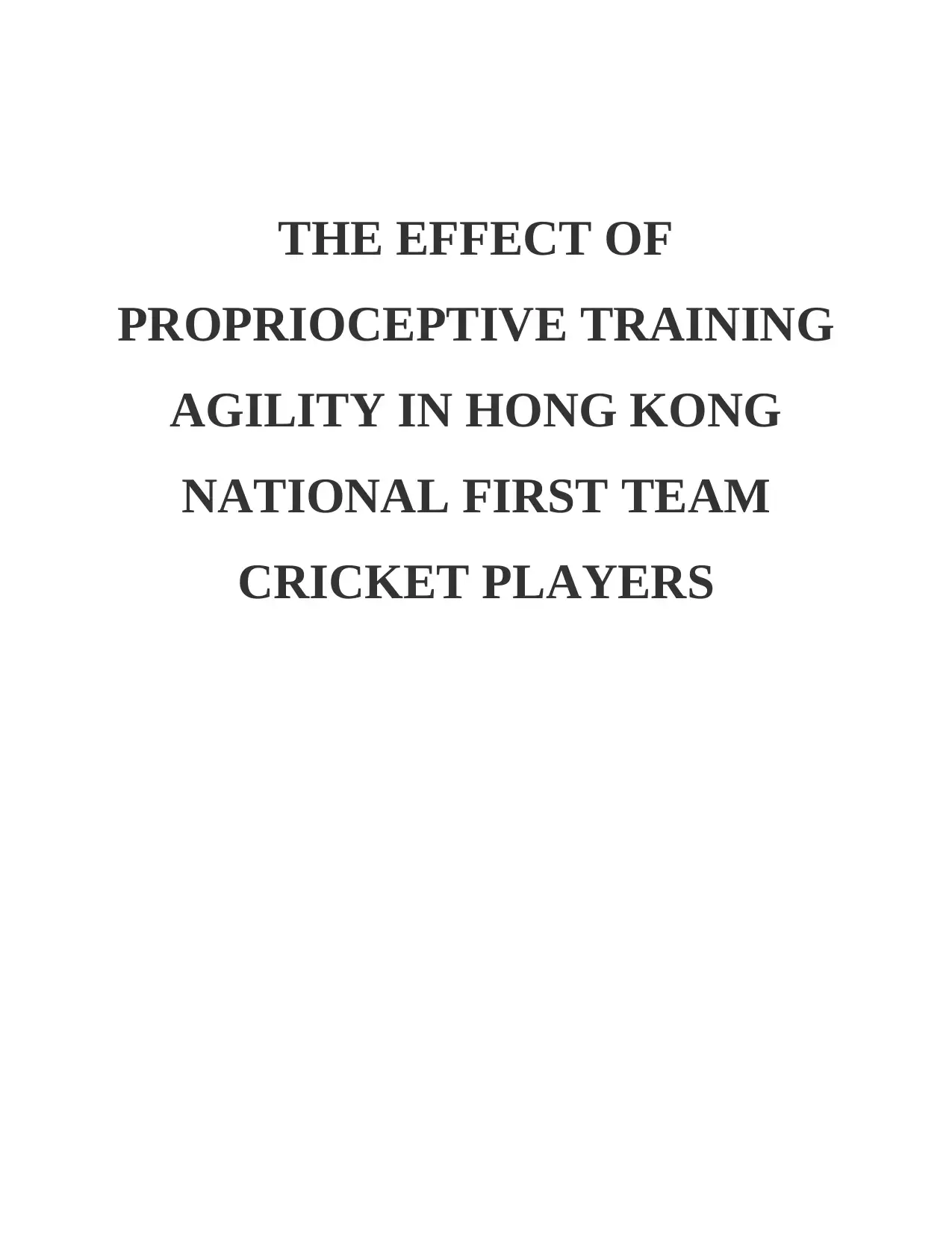
THE EFFECT OF
PROPRIOCEPTIVE TRAINING
AGILITY IN HONG KONG
NATIONAL FIRST TEAM
CRICKET PLAYERS
PROPRIOCEPTIVE TRAINING
AGILITY IN HONG KONG
NATIONAL FIRST TEAM
CRICKET PLAYERS
Paraphrase This Document
Need a fresh take? Get an instant paraphrase of this document with our AI Paraphraser
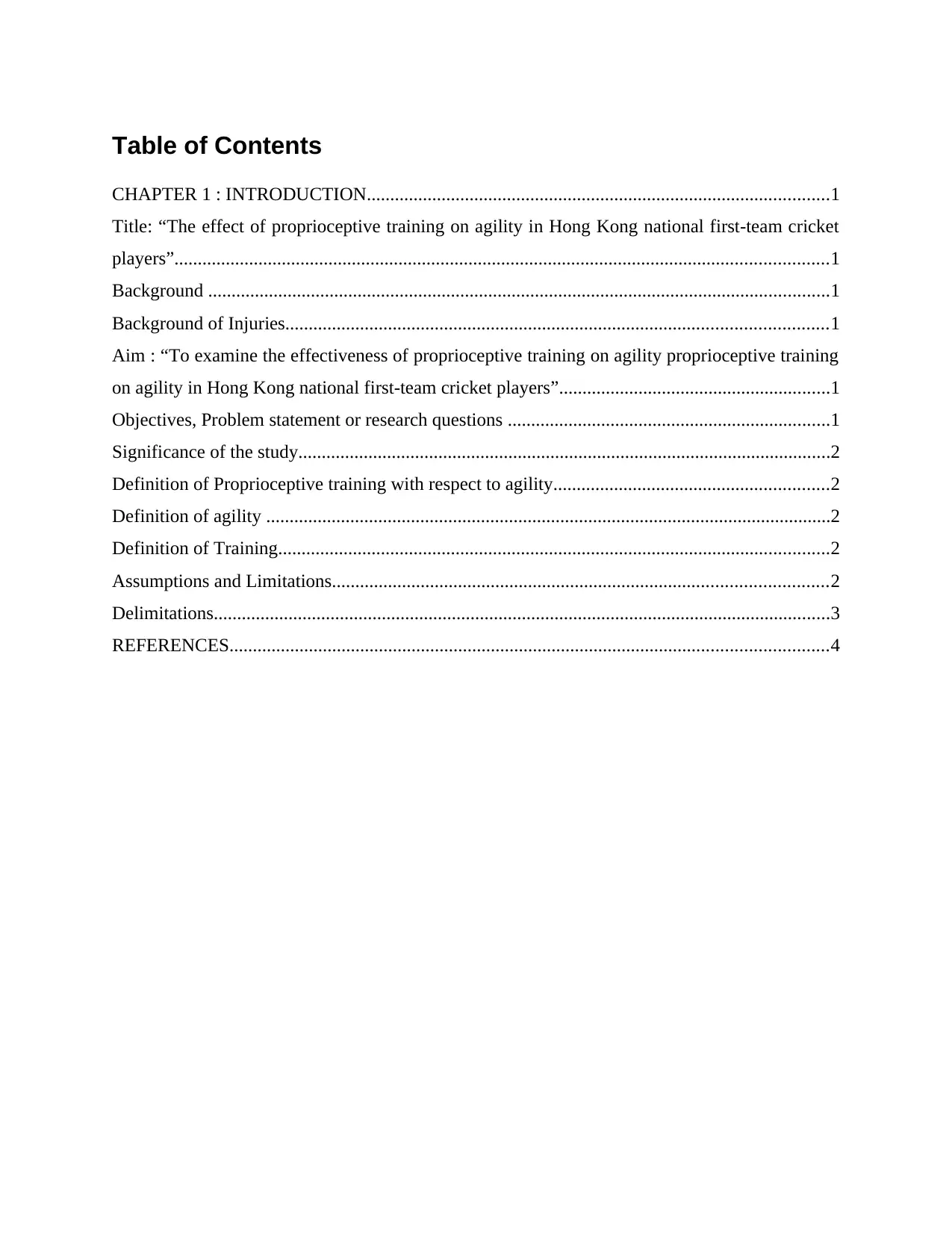
Table of Contents
CHAPTER 1 : INTRODUCTION...................................................................................................1
Title: “The effect of proprioceptive training on agility in Hong Kong national first-team cricket
players”............................................................................................................................................1
Background .....................................................................................................................................1
Background of Injuries....................................................................................................................1
Aim : “To examine the effectiveness of proprioceptive training on agility proprioceptive training
on agility in Hong Kong national first-team cricket players”..........................................................1
Objectives, Problem statement or research questions .....................................................................1
Significance of the study..................................................................................................................2
Definition of Proprioceptive training with respect to agility...........................................................2
Definition of agility .........................................................................................................................2
Definition of Training......................................................................................................................2
Assumptions and Limitations..........................................................................................................2
Delimitations....................................................................................................................................3
REFERENCES................................................................................................................................4
CHAPTER 1 : INTRODUCTION...................................................................................................1
Title: “The effect of proprioceptive training on agility in Hong Kong national first-team cricket
players”............................................................................................................................................1
Background .....................................................................................................................................1
Background of Injuries....................................................................................................................1
Aim : “To examine the effectiveness of proprioceptive training on agility proprioceptive training
on agility in Hong Kong national first-team cricket players”..........................................................1
Objectives, Problem statement or research questions .....................................................................1
Significance of the study..................................................................................................................2
Definition of Proprioceptive training with respect to agility...........................................................2
Definition of agility .........................................................................................................................2
Definition of Training......................................................................................................................2
Assumptions and Limitations..........................................................................................................2
Delimitations....................................................................................................................................3
REFERENCES................................................................................................................................4
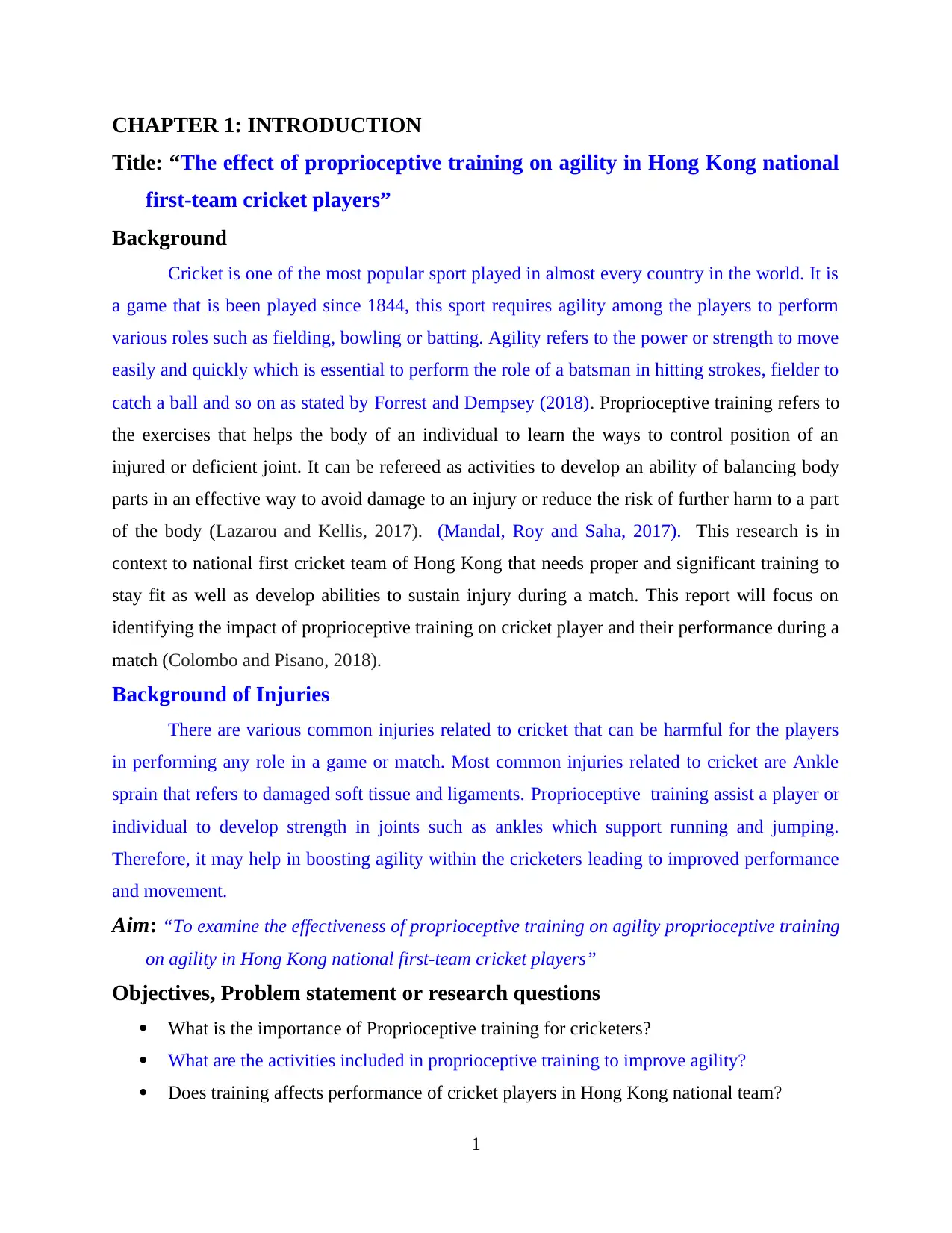
CHAPTER 1: INTRODUCTION
Title: “The effect of proprioceptive training on agility in Hong Kong national
first-team cricket players”
Background
Cricket is one of the most popular sport played in almost every country in the world. It is
a game that is been played since 1844, this sport requires agility among the players to perform
various roles such as fielding, bowling or batting. Agility refers to the power or strength to move
easily and quickly which is essential to perform the role of a batsman in hitting strokes, fielder to
catch a ball and so on as stated by Forrest and Dempsey (2018). Proprioceptive training refers to
the exercises that helps the body of an individual to learn the ways to control position of an
injured or deficient joint. It can be refereed as activities to develop an ability of balancing body
parts in an effective way to avoid damage to an injury or reduce the risk of further harm to a part
of the body (Lazarou and Kellis, 2017). (Mandal, Roy and Saha, 2017). This research is in
context to national first cricket team of Hong Kong that needs proper and significant training to
stay fit as well as develop abilities to sustain injury during a match. This report will focus on
identifying the impact of proprioceptive training on cricket player and their performance during a
match (Colombo and Pisano, 2018).
Background of Injuries
There are various common injuries related to cricket that can be harmful for the players
in performing any role in a game or match. Most common injuries related to cricket are Ankle
sprain that refers to damaged soft tissue and ligaments. Proprioceptive training assist a player or
individual to develop strength in joints such as ankles which support running and jumping.
Therefore, it may help in boosting agility within the cricketers leading to improved performance
and movement.
Aim: “To examine the effectiveness of proprioceptive training on agility proprioceptive training
on agility in Hong Kong national first-team cricket players”
Objectives, Problem statement or research questions
What is the importance of Proprioceptive training for cricketers?
What are the activities included in proprioceptive training to improve agility?
Does training affects performance of cricket players in Hong Kong national team?
1
Title: “The effect of proprioceptive training on agility in Hong Kong national
first-team cricket players”
Background
Cricket is one of the most popular sport played in almost every country in the world. It is
a game that is been played since 1844, this sport requires agility among the players to perform
various roles such as fielding, bowling or batting. Agility refers to the power or strength to move
easily and quickly which is essential to perform the role of a batsman in hitting strokes, fielder to
catch a ball and so on as stated by Forrest and Dempsey (2018). Proprioceptive training refers to
the exercises that helps the body of an individual to learn the ways to control position of an
injured or deficient joint. It can be refereed as activities to develop an ability of balancing body
parts in an effective way to avoid damage to an injury or reduce the risk of further harm to a part
of the body (Lazarou and Kellis, 2017). (Mandal, Roy and Saha, 2017). This research is in
context to national first cricket team of Hong Kong that needs proper and significant training to
stay fit as well as develop abilities to sustain injury during a match. This report will focus on
identifying the impact of proprioceptive training on cricket player and their performance during a
match (Colombo and Pisano, 2018).
Background of Injuries
There are various common injuries related to cricket that can be harmful for the players
in performing any role in a game or match. Most common injuries related to cricket are Ankle
sprain that refers to damaged soft tissue and ligaments. Proprioceptive training assist a player or
individual to develop strength in joints such as ankles which support running and jumping.
Therefore, it may help in boosting agility within the cricketers leading to improved performance
and movement.
Aim: “To examine the effectiveness of proprioceptive training on agility proprioceptive training
on agility in Hong Kong national first-team cricket players”
Objectives, Problem statement or research questions
What is the importance of Proprioceptive training for cricketers?
What are the activities included in proprioceptive training to improve agility?
Does training affects performance of cricket players in Hong Kong national team?
1
⊘ This is a preview!⊘
Do you want full access?
Subscribe today to unlock all pages.

Trusted by 1+ million students worldwide
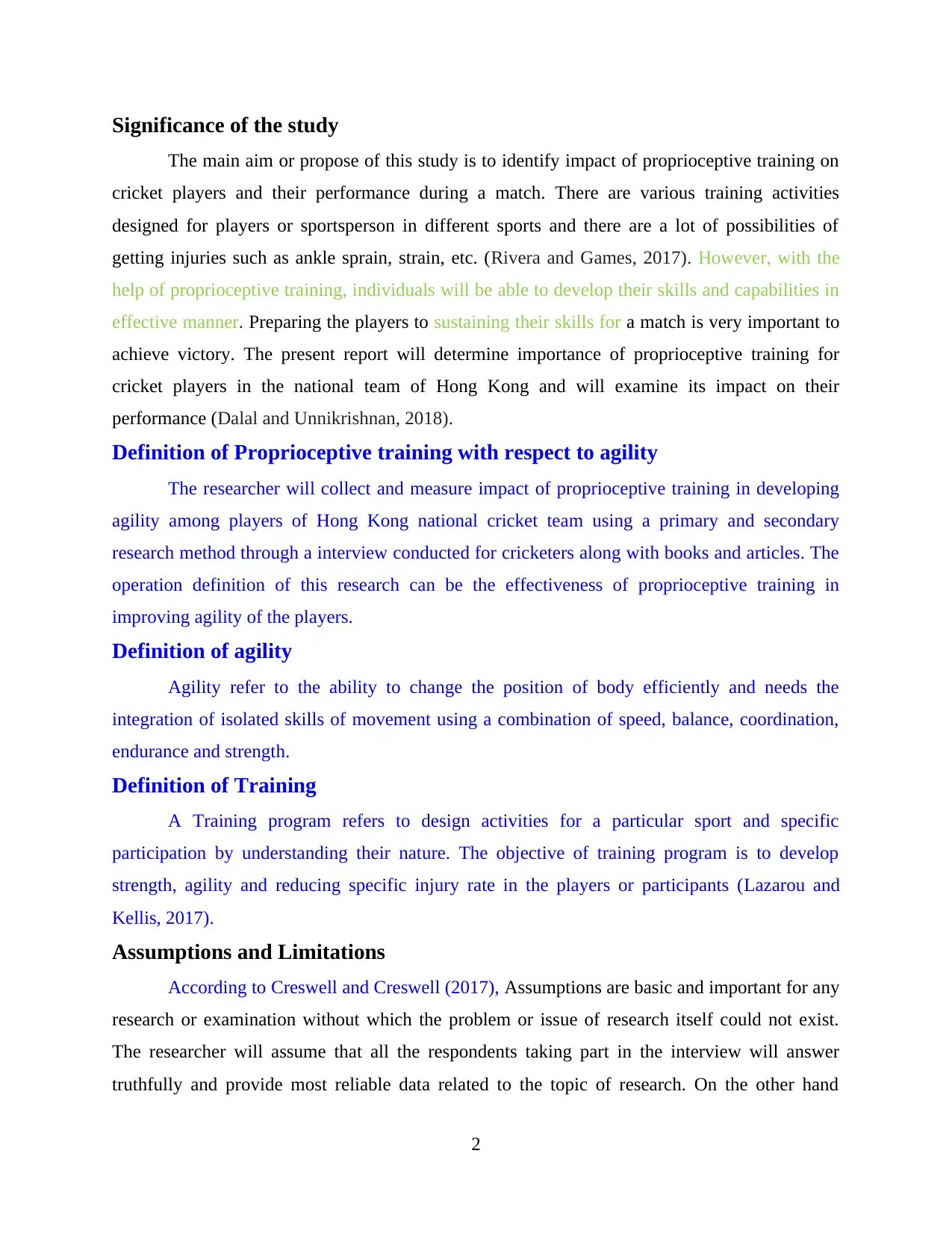
Significance of the study
The main aim or propose of this study is to identify impact of proprioceptive training on
cricket players and their performance during a match. There are various training activities
designed for players or sportsperson in different sports and there are a lot of possibilities of
getting injuries such as ankle sprain, strain, etc. (Rivera and Games, 2017). However, with the
help of proprioceptive training, individuals will be able to develop their skills and capabilities in
effective manner. Preparing the players to sustaining their skills for a match is very important to
achieve victory. The present report will determine importance of proprioceptive training for
cricket players in the national team of Hong Kong and will examine its impact on their
performance (Dalal and Unnikrishnan, 2018).
Definition of Proprioceptive training with respect to agility
The researcher will collect and measure impact of proprioceptive training in developing
agility among players of Hong Kong national cricket team using a primary and secondary
research method through a interview conducted for cricketers along with books and articles. The
operation definition of this research can be the effectiveness of proprioceptive training in
improving agility of the players.
Definition of agility
Agility refer to the ability to change the position of body efficiently and needs the
integration of isolated skills of movement using a combination of speed, balance, coordination,
endurance and strength.
Definition of Training
A Training program refers to design activities for a particular sport and specific
participation by understanding their nature. The objective of training program is to develop
strength, agility and reducing specific injury rate in the players or participants (Lazarou and
Kellis, 2017).
Assumptions and Limitations
According to Creswell and Creswell (2017), Assumptions are basic and important for any
research or examination without which the problem or issue of research itself could not exist.
The researcher will assume that all the respondents taking part in the interview will answer
truthfully and provide most reliable data related to the topic of research. On the other hand
2
The main aim or propose of this study is to identify impact of proprioceptive training on
cricket players and their performance during a match. There are various training activities
designed for players or sportsperson in different sports and there are a lot of possibilities of
getting injuries such as ankle sprain, strain, etc. (Rivera and Games, 2017). However, with the
help of proprioceptive training, individuals will be able to develop their skills and capabilities in
effective manner. Preparing the players to sustaining their skills for a match is very important to
achieve victory. The present report will determine importance of proprioceptive training for
cricket players in the national team of Hong Kong and will examine its impact on their
performance (Dalal and Unnikrishnan, 2018).
Definition of Proprioceptive training with respect to agility
The researcher will collect and measure impact of proprioceptive training in developing
agility among players of Hong Kong national cricket team using a primary and secondary
research method through a interview conducted for cricketers along with books and articles. The
operation definition of this research can be the effectiveness of proprioceptive training in
improving agility of the players.
Definition of agility
Agility refer to the ability to change the position of body efficiently and needs the
integration of isolated skills of movement using a combination of speed, balance, coordination,
endurance and strength.
Definition of Training
A Training program refers to design activities for a particular sport and specific
participation by understanding their nature. The objective of training program is to develop
strength, agility and reducing specific injury rate in the players or participants (Lazarou and
Kellis, 2017).
Assumptions and Limitations
According to Creswell and Creswell (2017), Assumptions are basic and important for any
research or examination without which the problem or issue of research itself could not exist.
The researcher will assume that all the respondents taking part in the interview will answer
truthfully and provide most reliable data related to the topic of research. On the other hand
2
Paraphrase This Document
Need a fresh take? Get an instant paraphrase of this document with our AI Paraphraser
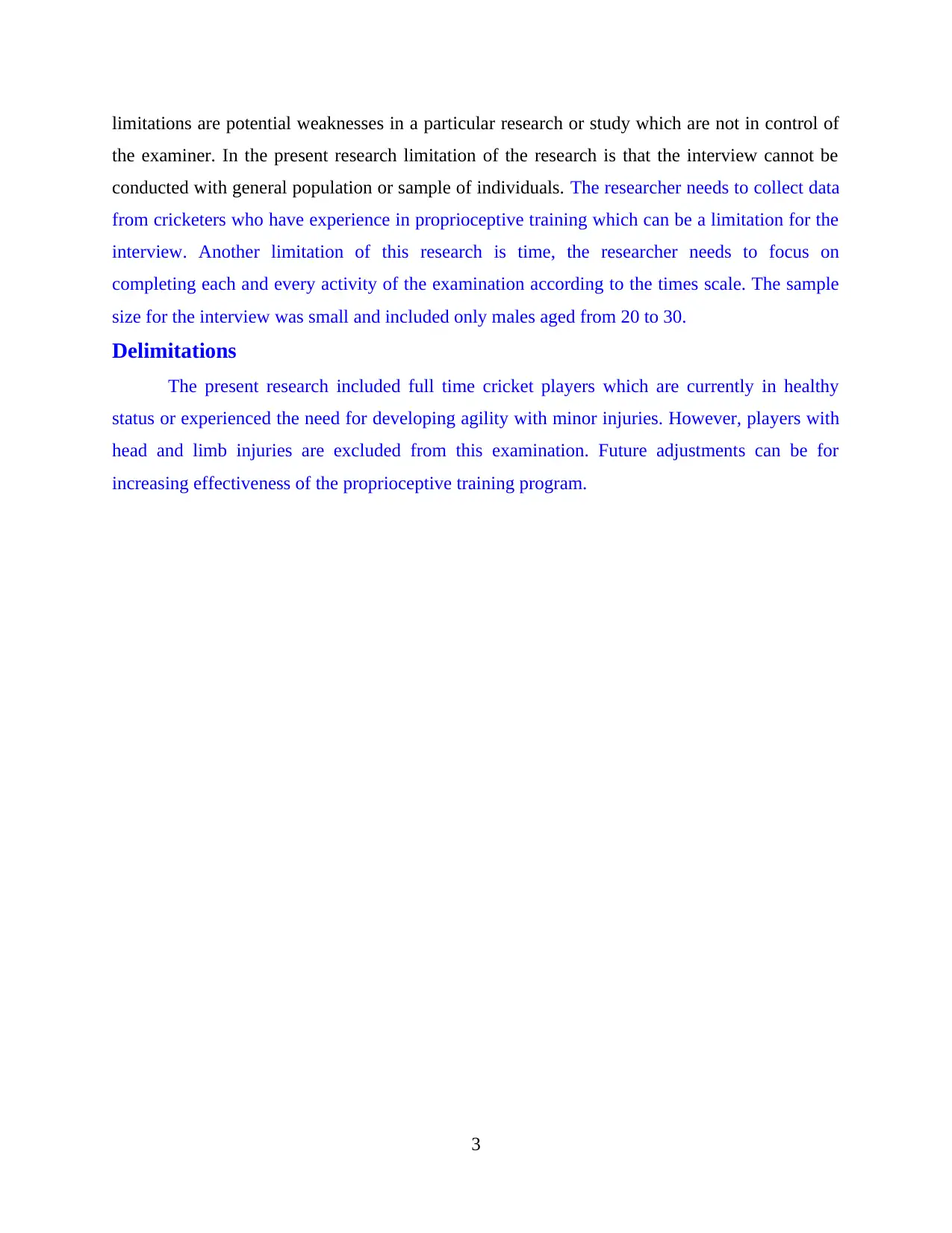
limitations are potential weaknesses in a particular research or study which are not in control of
the examiner. In the present research limitation of the research is that the interview cannot be
conducted with general population or sample of individuals. The researcher needs to collect data
from cricketers who have experience in proprioceptive training which can be a limitation for the
interview. Another limitation of this research is time, the researcher needs to focus on
completing each and every activity of the examination according to the times scale. The sample
size for the interview was small and included only males aged from 20 to 30.
Delimitations
The present research included full time cricket players which are currently in healthy
status or experienced the need for developing agility with minor injuries. However, players with
head and limb injuries are excluded from this examination. Future adjustments can be for
increasing effectiveness of the proprioceptive training program.
3
the examiner. In the present research limitation of the research is that the interview cannot be
conducted with general population or sample of individuals. The researcher needs to collect data
from cricketers who have experience in proprioceptive training which can be a limitation for the
interview. Another limitation of this research is time, the researcher needs to focus on
completing each and every activity of the examination according to the times scale. The sample
size for the interview was small and included only males aged from 20 to 30.
Delimitations
The present research included full time cricket players which are currently in healthy
status or experienced the need for developing agility with minor injuries. However, players with
head and limb injuries are excluded from this examination. Future adjustments can be for
increasing effectiveness of the proprioceptive training program.
3
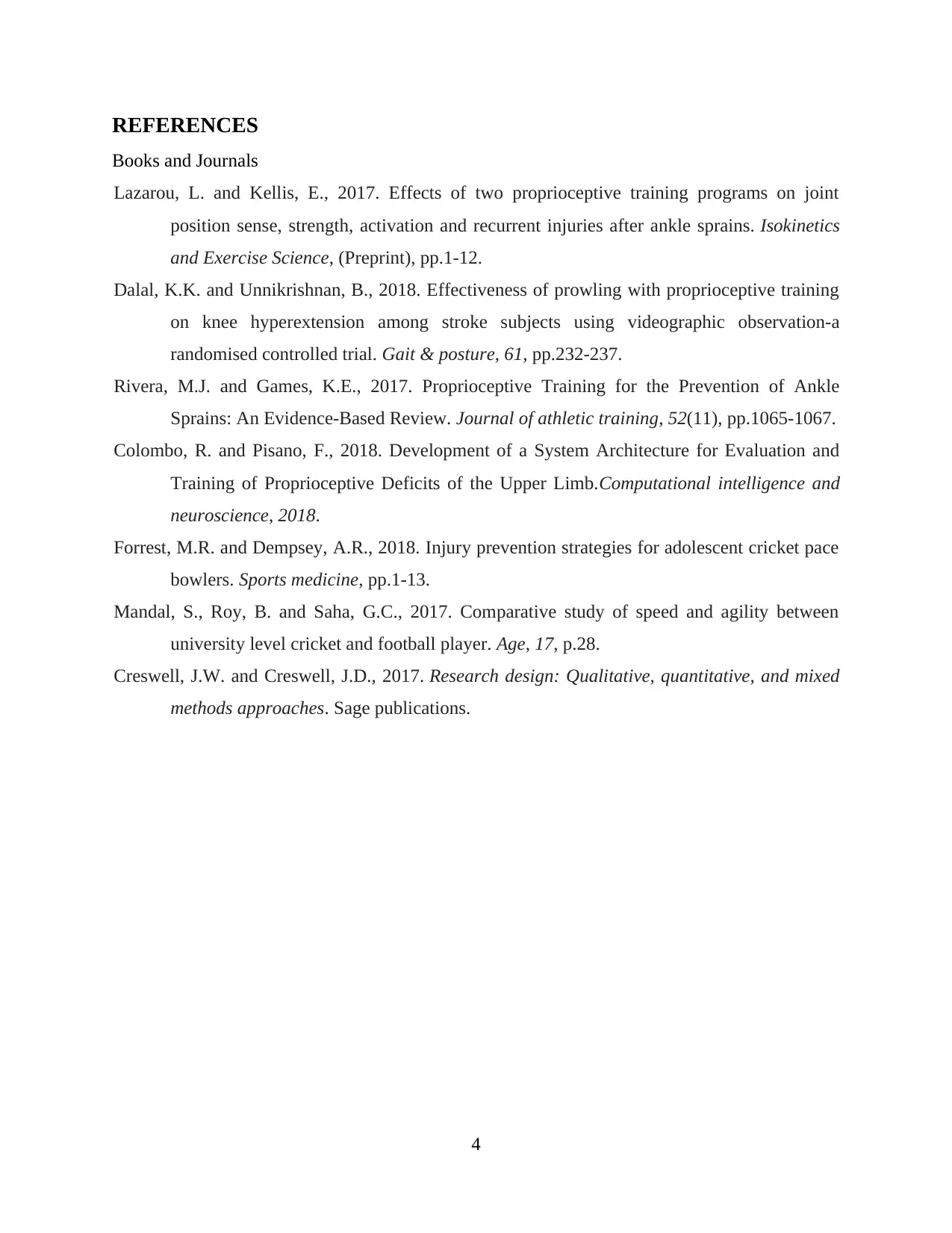
REFERENCES
Books and Journals
Lazarou, L. and Kellis, E., 2017. Effects of two proprioceptive training programs on joint
position sense, strength, activation and recurrent injuries after ankle sprains. Isokinetics
and Exercise Science, (Preprint), pp.1-12.
Dalal, K.K. and Unnikrishnan, B., 2018. Effectiveness of prowling with proprioceptive training
on knee hyperextension among stroke subjects using videographic observation-a
randomised controlled trial. Gait & posture, 61, pp.232-237.
Rivera, M.J. and Games, K.E., 2017. Proprioceptive Training for the Prevention of Ankle
Sprains: An Evidence-Based Review. Journal of athletic training, 52(11), pp.1065-1067.
Colombo, R. and Pisano, F., 2018. Development of a System Architecture for Evaluation and
Training of Proprioceptive Deficits of the Upper Limb.Computational intelligence and
neuroscience, 2018.
Forrest, M.R. and Dempsey, A.R., 2018. Injury prevention strategies for adolescent cricket pace
bowlers. Sports medicine, pp.1-13.
Mandal, S., Roy, B. and Saha, G.C., 2017. Comparative study of speed and agility between
university level cricket and football player. Age, 17, p.28.
Creswell, J.W. and Creswell, J.D., 2017. Research design: Qualitative, quantitative, and mixed
methods approaches. Sage publications.
4
Books and Journals
Lazarou, L. and Kellis, E., 2017. Effects of two proprioceptive training programs on joint
position sense, strength, activation and recurrent injuries after ankle sprains. Isokinetics
and Exercise Science, (Preprint), pp.1-12.
Dalal, K.K. and Unnikrishnan, B., 2018. Effectiveness of prowling with proprioceptive training
on knee hyperextension among stroke subjects using videographic observation-a
randomised controlled trial. Gait & posture, 61, pp.232-237.
Rivera, M.J. and Games, K.E., 2017. Proprioceptive Training for the Prevention of Ankle
Sprains: An Evidence-Based Review. Journal of athletic training, 52(11), pp.1065-1067.
Colombo, R. and Pisano, F., 2018. Development of a System Architecture for Evaluation and
Training of Proprioceptive Deficits of the Upper Limb.Computational intelligence and
neuroscience, 2018.
Forrest, M.R. and Dempsey, A.R., 2018. Injury prevention strategies for adolescent cricket pace
bowlers. Sports medicine, pp.1-13.
Mandal, S., Roy, B. and Saha, G.C., 2017. Comparative study of speed and agility between
university level cricket and football player. Age, 17, p.28.
Creswell, J.W. and Creswell, J.D., 2017. Research design: Qualitative, quantitative, and mixed
methods approaches. Sage publications.
4
⊘ This is a preview!⊘
Do you want full access?
Subscribe today to unlock all pages.

Trusted by 1+ million students worldwide
1 out of 6
Related Documents
Your All-in-One AI-Powered Toolkit for Academic Success.
+13062052269
info@desklib.com
Available 24*7 on WhatsApp / Email
![[object Object]](/_next/static/media/star-bottom.7253800d.svg)
Unlock your academic potential
Copyright © 2020–2025 A2Z Services. All Rights Reserved. Developed and managed by ZUCOL.





